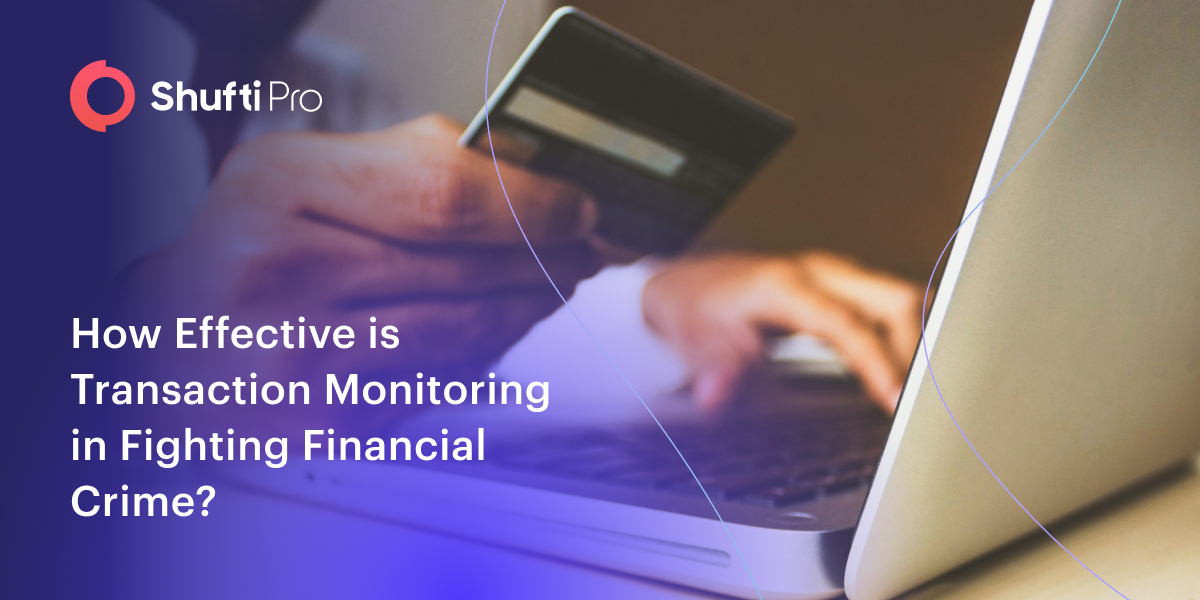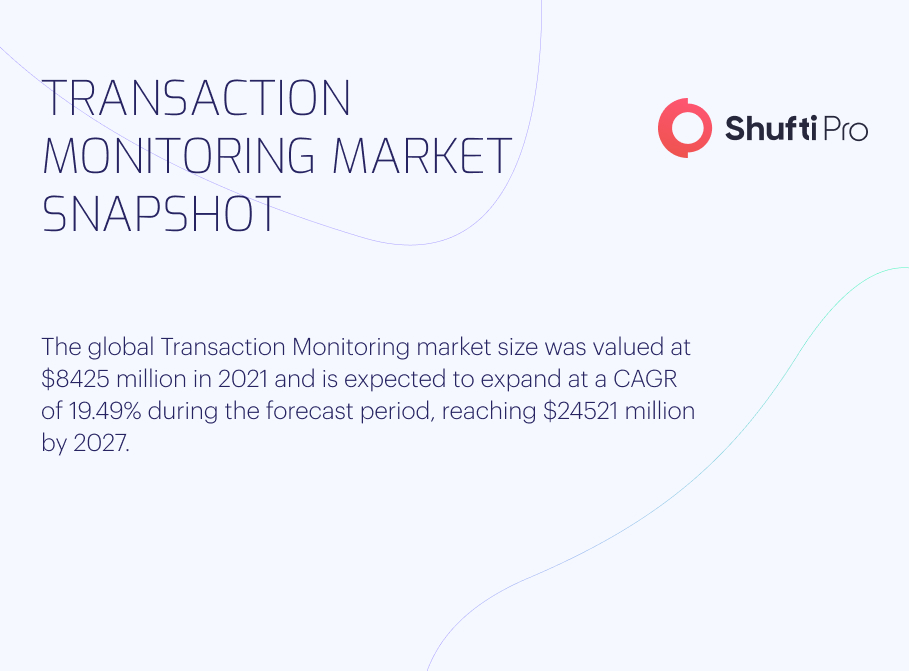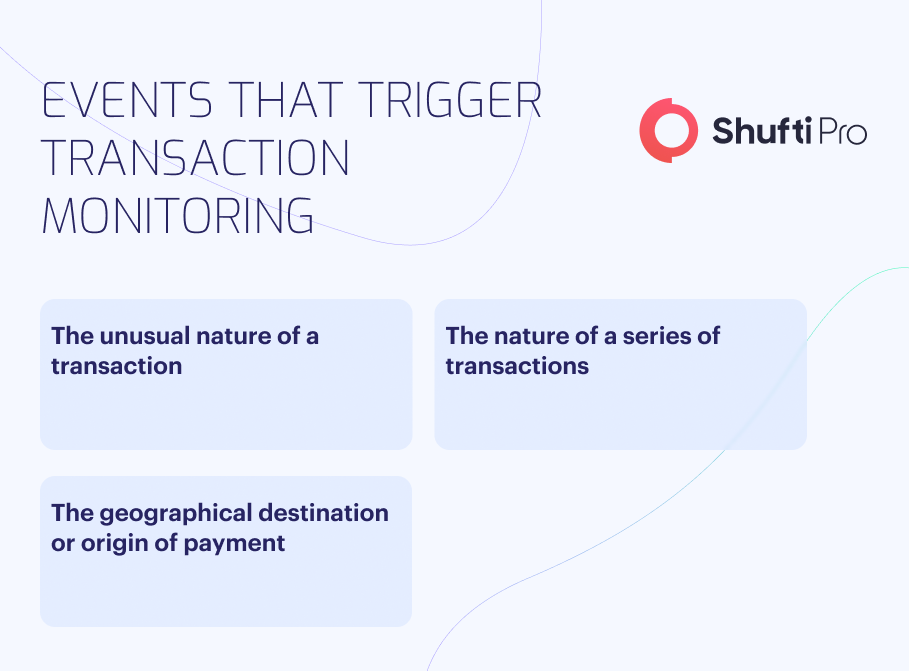How Effective is Transaction Monitoring in Fighting Financial Crime?

As per the United Nation’s calculations, nearly $2 trillion is laundered annually worldwide, adversely impacting the financial industry. However, approximately 91% of the criminals end up in prison, whilst 90% of the money laundering crimes go undetected. The numbers are increasing yearly as businesses fail to implement strict Know Your Customer and anti-money laundering controls, giving criminals an open field to launder money.
Having no effective AML and transaction monitoring systems, businesses usually fail to detect and prevent the criminals’ activities, particularly irregular transactions that cost them millions of dollars – in the form of regulatory non-compliance fines or reputational damages. As just one example, The Monetary Authority of Singapore (MAS) has imposed $7.8m fines on financial sector businesses, $7.1m from these penalties were crimes related to not complying with AML and CFT regulations.
Clearly, financial firms have a social responsibility as well as a regulatory obligation to fight such activities whilst ensuring that money launderers are not using them. To do so, transaction monitoring systems fill the gap.
What Is Transaction Monitoring?
Transaction monitoring is an effective approach to reactively identifying outlier events, such as financial transactions or company arrangements, using pre-defined rules and data to highlight suspicious payments, further requiring manual reviews.
At its core, practicing transaction monitoring is critical in today’s digital world, where fraud is prevalent. It helps financial institutions and other businesses detect and eliminate the risk of terrorist financing, money laundering, and other bogus financial crimes that become the barrier in balancing the art of security and safety across nations.
With the surging rates of money laundering implications, global regulatory bodies and governments have cracked down on companies that lack the in-house anti-money laundering controls as well as the power to stop criminals at the bay.

Here is a sneak peek into stories of non-compliant businesses:
Deutsche Bank Subordinate DWS Fined $25 Million For AML Violations
The Security Exchange Commission (SEC), in its recent law enforcement action, imposed a $25 million fine on DWS Investment Management, a subsidiary of Deutsche Bank, for anti-money laundering and suspicious activity reporting failings.
The financial watchdog has penalised the company for providing misleading information about its Environmental, Social, and Governance (ESG) investment strategies as well as having ineffective measures to detect and eliminate risk of financial crimes. After accepting the allegations, DWS agreed to pay the fine for violating regulatory obligations. In the SEC’s crackdown, the committee discovered that the company could not also implement adequate AML controls designed to help businesses meet the Bank Secrecy Act (BSA) and Financial Crimes Enforcement Network (FinCEN) obligations.
The SEC director stated, “The SEC’s order finds that DWS advised mutual funds with billions of dollars in assets yet failed to ensure that the funds had an AML program tailored to their specific risks, as required by law. Importantly, those AML obligations require mutual funds to establish and implement individualized programmes to detect and prevent money laundering and terrorism financing. I congratulate the Asset Management Unit for bringing this important mutual fund AML enforcement action.”
Suggested Read: Deutsche Bank Subordinate DWS Fined $25 Million for AML Violations
Abu Dhabi’s Regulatory Authority Fines Pyypl $486,000 For Violating Money Laundering Laws
The Abu Dhabi Global Market (ADGM) financial watchdog recently imposed a $486,000 fine on UAE’s digital bank Pyypl for having ineffective anti-money laundering measures. According to the regulatory authority’s findings, the company has violated the country’s AML laws by not practicing risk assessment and customer due diligence measures. Furthermore, from March 2021 to November 2022, the financial firm failed to maintain and comply with the anti-money laundering standards as they were supposed to be. ADGM added in its statement that Pyypl Bank could have taken responsibility by effectively monitoring and reporting suspicious transactions.
Suggested Read: Abu Dhabi Regulatory Authority Fines Pyypl $486,000 For Violating Money Laundering Laws
Transaction Monitoring | A Risk-Based Approach to Mitigate Financial Crime
Financial firms and the banking sector are some of the heavily regulated industries as well as the top target of the money launderers. To secure operations, safeguard reputation, and avoid non-compliance fines, the world’s prominent financial watchdogs, including FATF, FinCEN, AUSTRAC, etc, have developed a risk-based approach for businesses to meet transaction monitoring obligations. Under this, financial firms need to conduct thorough risk assessments of customers while implementing effective anti-money laundering measures to eliminate emerging threats.
Transaction monitoring involves screening high-risk customers and payments that demand enhanced due diligence, whilst low-risk clients are subject to simplified or standard due diligence measures. Assessing and developing accurate risk profiles are viable for conducting effective transaction monitoring measures.
To ensure the effectiveness of the transaction monitoring solutions, the following are some of the essential checks that businesses must need to know:
Customer Due Diligence: Financial institutions are obliged to identify and verify their customers’ true identities before getting them onboard or allowing them to make payments. To do so, banks need to gather personally identifiable information such as name, ID card number, driver’s license, and much more. The acquired information helps financial firms assess risk and countermeasures to neutralize the impact.
Sanctions Screening: Screening customers against a global sanction list is a must for businesses dealing with financial transactions. By doing this, companies can identify high-risk customers by searching global financial crime databases whilst taking steps accordingly.
Identifying Politically Exposed Persons (PEPs) : The high-risk customers, including elected or government officials, are subject to PEP screening as they pose a higher money laundering risk. However, to detect such customers, businesses need to continually screen their customers against PEP lists.
Adverse Media Searching: A customer being present in an adverse media list is also a ref flag and increases the risk level associated with transactions. Therefore, financial institutions need to monitor adverse media sources to update their customers actively; risk profiles. Implementing these measures can help businesses meet anti-money laundering compliance whilst managing risk effectively.

Transaction Monitoring Challenges
Like Know Your Customer and anti-money laundering, transaction monitoring poses various business challenges. Here are the top three challenges that most businesses face whilst implementing transaction monitoring systems:
Handling False Positives
These are some of the most occurring and significant challenges faced by banks and other businesses whilst implementing in-house transaction monitoring processes. False positive occurs when a predefined rule causes the legitimate transaction as suspicious or high risk and vice versa, leading to increased reviewing efforts and distracting the compliance officers from paying attention to the actual bogus transactions.
Evolving Regulatory Landscape
Being regulated strictly, financial firms need to stay updated with the ever-evolving regulatory landscape to seamlessly implement transaction monitoring. Financial watchdogs develop new guidelines, regulations, and best practices to address the evolving risk whilst enhancing the effectiveness of AML practices. However, staying informed with regular updates and aligning the person with compliance controls becomes challenging for businesses that use conventional transaction monitoring systems.
Balancing Accuracy and Efficiency
Maintaining a balance between efficiency and accuracy in transaction monitoring systems becomes a significant operational challenge for businesses. In-house compliance experts review thousands of transactional records to identify irregular patterns and potential money laundering risks. However, the vast amount of data can be overwhelming, leading to an increased number of false positives and the hassle of manual reviews. Achieving a perfect balance requires leveraging advanced and automated transaction monitoring systems to streamline risk detection, mitigate false positives, and automate manual reviews.
Transaction Monitoring with Shufti
Transaction monitoring is an essential part of the anti-money laundering process and mandatory for any business dealing with transactions and subject to anti-money laundering regulations. Depending on the nature of the business and the level of risk involved, companies may follow simple, traditional rule-based transaction monitoring protocols or an AI-powered enhanced approach to detect suspicious activities whilst taking adequate preventive measures.
Shufti’s smart, robust, and fully automated AML transaction monitoring service is trusted by 1000+ businesses worldwide and transforms their compliance processes with a competitive edge. Our sophisticated solution can screen companies and individuals against 1700+ global financial crime watchlists in a matter of seconds. The process identifies high-risk entities, suspicious transactions, and true identities by leveraging the power of artificial intelligence whilst delivering 99.77% accurate results.
Want to learn more about how our AML transaction monitoring solution can help your business effectively manage and mitigate risk whilst keeping money launderers at the bay?











